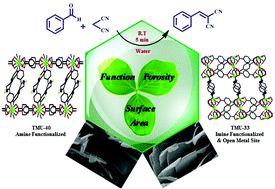Size and function influence study on enhanced catalytic performance of a cooperative MOF for mild, green and fast C–C bond formation†
Abstract
Tuning of pore function and size (surface area) are two key factors that play important roles in the performance of metal–organic-frameworks (MOFs) as catalysts. The catalytic performance of two bulk and nanosized MOFs with different functional groups such as a Brønsted base and Lewis acid was studied in line with the sustainable development of catalysts and green chemistry principles. Bifunctional imine decorated TMU-33, ([Cd3(BDC)3(OPP)(DMF)2]·2DMA)n (TMU-33), (OPP: N,N′-(oxybis(4,1-phenylene))bis(1-(pyridin-4yl)methanimine)), with an adjustable structure and amine functionalized TMU-40, [Zn(BDC)(L*)]·DMF, (L*: N1,N2-bis(pyridin-4-ylmethylene)ethane-1,2-diamine), were evaluated in the C–C bond forming reaction under mild and green conditions. The results show that the nanosized samples of bifunctional TMU-33 which simultaneously have an imine and open metal site exhibit higher performance as Knoevenagel catalysts. Furthermore, among the nanosized samples, the nanoplate TMU-33 with more access to open metal sites shows the highest catalytic activity without any side product in water, at room temperature for 5 min, which confirms that the Lewis acid is the effective catalyst for this reaction. The catalyst could be reused for at least three cycles without any significant loss of its activity. The performance of the structure indicates that the tuning of functionality of MOFs can be a very promising route for the extension of green catalysts.



 Please wait while we load your content...
Please wait while we load your content...